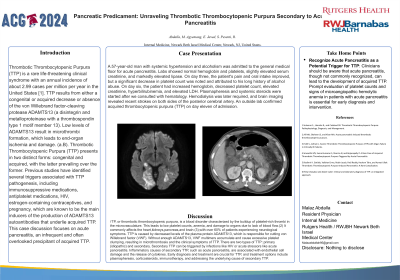Tuesday Poster Session
Category: Biliary/Pancreas
P3555 - Pancreatic Predicament: Unraveling Thrombotic Thrombocytopenic Purpura Secondary to Acute Pancreatitis - A Case Report
Tuesday, October 29, 2024
10:30 AM - 4:00 PM ET
Location: Exhibit Hall E


Malaz Abdallah, MD
Newark Beth Israel Medical Center
Newark, NJ
Presenting Author(s)
Malaz Abdallah, MD, Emmanuel Agyemang, MD, Raymond Pesenti, MD, Saamia Javed, MD, Daniel Augh, MD, Daniel Short, MD
Newark Beth Israel Medical Center, Newark, NJ
Introduction: Thrombotic Thrombocytopenic Purpura (TTP) is a rare, life-threatening clinical syndrome with an annual incidence of about 2.99 cases per million per year in the United States [1]. A congenital or acquired decrease or absence of the von Willebrand factor-cleaving protease ADAMTS13 causes TTP. Previous studies have identified numerous infectious and inflammatory conditions as the main inducers of ADAMTS13 autoantibodies that cause acquired TTP. This case discusses acute pancreatitis, a rare and overlooked cause of acquired TTP.
Case Description/Methods: A 57-year-old man with systemic hypertension and alcoholism was admitted to the general medical floor for acute pancreatitis. Labs showed normal hemoglobin and platelets, slightly elevated serum creatinine, and markedly elevated lipase. On day three, the patient's pain and oral intake improved, but a significant decrease in platelet count was noted and attributed to his long history of alcohol abuse. On day six, the patient had increased hemoglobin, decreased platelet count, elevated creatinine, hyperbilirubinemia, and elevated LDH. Plasmapheresis and systemic steroids were started after we consulted with hematology. Hemodialysis was later required, and brain imaging revealed recent strokes on both sides of the posterior cerebral artery. An outside lab confirmed acquired thrombocytopenic purpura (TTP) on day eleven of admission.
Discussion: TTP, or thrombotic thrombocytopenic purpura, is a blood disorder characterized by the buildup of platelet-rich thrombi in the microvasculature. This leads to low platelet counts, anemia, and damage to organs due to lack of blood flow.(2) It commonly affects the heart,kidneys,pancreas,and brain (3),with over 60% of patients experiencing neurological symptoms. TTP is caused by decreased levels of the plasma protein ADAMTS13, which is responsible for cutting von Willebrand factor (VWF). Without enough ADAMTS13, VWF multimers accumulate and cause excessive platelet clumping, resulting in microthrombosis and the clinical symptoms of TTP. There are two types of TTP: primary (idiopathic) and secondary. Secondary TTP can be triggered by infections like HIV or acute stressors like acute pancreatitis. Inflammatory causes of secondary TTP, such as acute pancreatitis, are associated with endothelial cell damage and the release of cytokines. Early diagnosis and treatment are crucial for TTP, and treatment options include plasmapheresis, corticosteroids, immunotherapy, and addressing the underlying cause of secondary TTP.
Disclosures:
Malaz Abdallah, MD, Emmanuel Agyemang, MD, Raymond Pesenti, MD, Saamia Javed, MD, Daniel Augh, MD, Daniel Short, MD. P3555 - Pancreatic Predicament: Unraveling Thrombotic Thrombocytopenic Purpura Secondary to Acute Pancreatitis - A Case Report, ACG 2024 Annual Scientific Meeting Abstracts. Philadelphia, PA: American College of Gastroenterology.
Newark Beth Israel Medical Center, Newark, NJ
Introduction: Thrombotic Thrombocytopenic Purpura (TTP) is a rare, life-threatening clinical syndrome with an annual incidence of about 2.99 cases per million per year in the United States [1]. A congenital or acquired decrease or absence of the von Willebrand factor-cleaving protease ADAMTS13 causes TTP. Previous studies have identified numerous infectious and inflammatory conditions as the main inducers of ADAMTS13 autoantibodies that cause acquired TTP. This case discusses acute pancreatitis, a rare and overlooked cause of acquired TTP.
Case Description/Methods: A 57-year-old man with systemic hypertension and alcoholism was admitted to the general medical floor for acute pancreatitis. Labs showed normal hemoglobin and platelets, slightly elevated serum creatinine, and markedly elevated lipase. On day three, the patient's pain and oral intake improved, but a significant decrease in platelet count was noted and attributed to his long history of alcohol abuse. On day six, the patient had increased hemoglobin, decreased platelet count, elevated creatinine, hyperbilirubinemia, and elevated LDH. Plasmapheresis and systemic steroids were started after we consulted with hematology. Hemodialysis was later required, and brain imaging revealed recent strokes on both sides of the posterior cerebral artery. An outside lab confirmed acquired thrombocytopenic purpura (TTP) on day eleven of admission.
Discussion: TTP, or thrombotic thrombocytopenic purpura, is a blood disorder characterized by the buildup of platelet-rich thrombi in the microvasculature. This leads to low platelet counts, anemia, and damage to organs due to lack of blood flow.(2) It commonly affects the heart,kidneys,pancreas,and brain (3),with over 60% of patients experiencing neurological symptoms. TTP is caused by decreased levels of the plasma protein ADAMTS13, which is responsible for cutting von Willebrand factor (VWF). Without enough ADAMTS13, VWF multimers accumulate and cause excessive platelet clumping, resulting in microthrombosis and the clinical symptoms of TTP. There are two types of TTP: primary (idiopathic) and secondary. Secondary TTP can be triggered by infections like HIV or acute stressors like acute pancreatitis. Inflammatory causes of secondary TTP, such as acute pancreatitis, are associated with endothelial cell damage and the release of cytokines. Early diagnosis and treatment are crucial for TTP, and treatment options include plasmapheresis, corticosteroids, immunotherapy, and addressing the underlying cause of secondary TTP.
Disclosures:
Malaz Abdallah indicated no relevant financial relationships.
Emmanuel Agyemang indicated no relevant financial relationships.
Raymond Pesenti indicated no relevant financial relationships.
Saamia Javed indicated no relevant financial relationships.
Daniel Augh indicated no relevant financial relationships.
Daniel Short indicated no relevant financial relationships.
Malaz Abdallah, MD, Emmanuel Agyemang, MD, Raymond Pesenti, MD, Saamia Javed, MD, Daniel Augh, MD, Daniel Short, MD. P3555 - Pancreatic Predicament: Unraveling Thrombotic Thrombocytopenic Purpura Secondary to Acute Pancreatitis - A Case Report, ACG 2024 Annual Scientific Meeting Abstracts. Philadelphia, PA: American College of Gastroenterology.
